Shiao Wang
ReasoningTrack: Chain-of-Thought Reasoning for Long-term Vision-Language Tracking
Aug 07, 2025Abstract:Vision-language tracking has received increasing attention in recent years, as textual information can effectively address the inflexibility and inaccuracy associated with specifying the target object to be tracked. Existing works either directly fuse the fixed language with vision features or simply modify using attention, however, their performance is still limited. Recently, some researchers have explored using text generation to adapt to the variations in the target during tracking, however, these works fail to provide insights into the model's reasoning process and do not fully leverage the advantages of large models, which further limits their overall performance. To address the aforementioned issues, this paper proposes a novel reasoning-based vision-language tracking framework, named ReasoningTrack, based on a pre-trained vision-language model Qwen2.5-VL. Both SFT (Supervised Fine-Tuning) and reinforcement learning GRPO are used for the optimization of reasoning and language generation. We embed the updated language descriptions and feed them into a unified tracking backbone network together with vision features. Then, we adopt a tracking head to predict the specific location of the target object. In addition, we propose a large-scale long-term vision-language tracking benchmark dataset, termed TNLLT, which contains 200 video sequences. 20 baseline visual trackers are re-trained and evaluated on this dataset, which builds a solid foundation for the vision-language visual tracking task. Extensive experiments on multiple vision-language tracking benchmark datasets fully validated the effectiveness of our proposed reasoning-based natural language generation strategy. The source code of this paper will be released on https://github.com/Event-AHU/Open_VLTrack
Towards Low-Latency Event Stream-based Visual Object Tracking: A Slow-Fast Approach
May 19, 2025Abstract:Existing tracking algorithms typically rely on low-frame-rate RGB cameras coupled with computationally intensive deep neural network architectures to achieve effective tracking. However, such frame-based methods inherently face challenges in achieving low-latency performance and often fail in resource-constrained environments. Visual object tracking using bio-inspired event cameras has emerged as a promising research direction in recent years, offering distinct advantages for low-latency applications. In this paper, we propose a novel Slow-Fast Tracking paradigm that flexibly adapts to different operational requirements, termed SFTrack. The proposed framework supports two complementary modes, i.e., a high-precision slow tracker for scenarios with sufficient computational resources, and an efficient fast tracker tailored for latency-aware, resource-constrained environments. Specifically, our framework first performs graph-based representation learning from high-temporal-resolution event streams, and then integrates the learned graph-structured information into two FlashAttention-based vision backbones, yielding the slow and fast trackers, respectively. The fast tracker achieves low latency through a lightweight network design and by producing multiple bounding box outputs in a single forward pass. Finally, we seamlessly combine both trackers via supervised fine-tuning and further enhance the fast tracker's performance through a knowledge distillation strategy. Extensive experiments on public benchmarks, including FE240, COESOT, and EventVOT, demonstrate the effectiveness and efficiency of our proposed method across different real-world scenarios. The source code has been released on https://github.com/Event-AHU/SlowFast_Event_Track.
RGB-Event based Pedestrian Attribute Recognition: A Benchmark Dataset and An Asymmetric RWKV Fusion Framework
Apr 14, 2025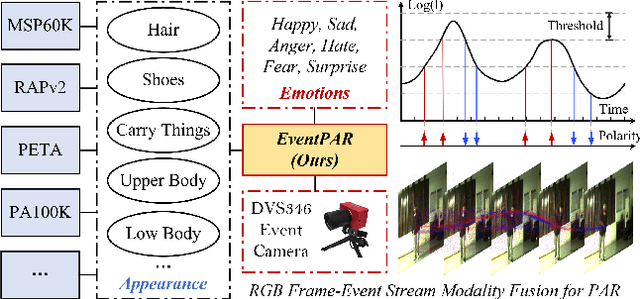
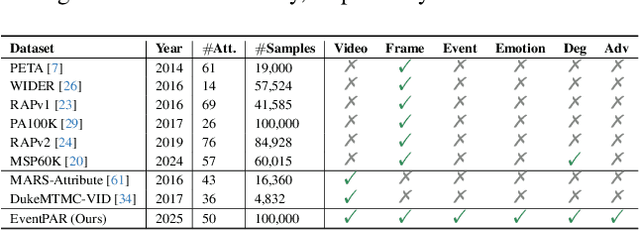

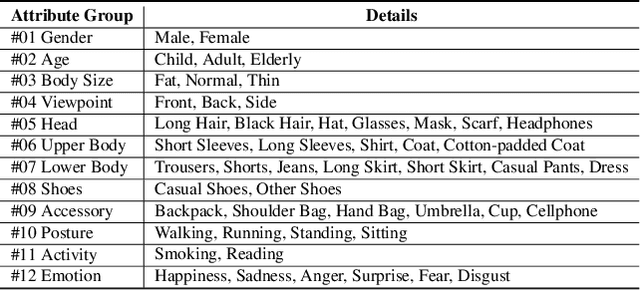
Abstract:Existing pedestrian attribute recognition methods are generally developed based on RGB frame cameras. However, these approaches are constrained by the limitations of RGB cameras, such as sensitivity to lighting conditions and motion blur, which hinder their performance. Furthermore, current attribute recognition primarily focuses on analyzing pedestrians' external appearance and clothing, lacking an exploration of emotional dimensions. In this paper, we revisit these issues and propose a novel multi-modal RGB-Event attribute recognition task by drawing inspiration from the advantages of event cameras in low-light, high-speed, and low-power consumption. Specifically, we introduce the first large-scale multi-modal pedestrian attribute recognition dataset, termed EventPAR, comprising 100K paired RGB-Event samples that cover 50 attributes related to both appearance and six human emotions, diverse scenes, and various seasons. By retraining and evaluating mainstream PAR models on this dataset, we establish a comprehensive benchmark and provide a solid foundation for future research in terms of data and algorithmic baselines. In addition, we propose a novel RWKV-based multi-modal pedestrian attribute recognition framework, featuring an RWKV visual encoder and an asymmetric RWKV fusion module. Extensive experiments are conducted on our proposed dataset as well as two simulated datasets (MARS-Attribute and DukeMTMC-VID-Attribute), achieving state-of-the-art results. The source code and dataset will be released on https://github.com/Event-AHU/OpenPAR
Human Activity Recognition using RGB-Event based Sensors: A Multi-modal Heat Conduction Model and A Benchmark Dataset
Apr 08, 2025



Abstract:Human Activity Recognition (HAR) primarily relied on traditional RGB cameras to achieve high-performance activity recognition. However, the challenging factors in real-world scenarios, such as insufficient lighting and rapid movements, inevitably degrade the performance of RGB cameras. To address these challenges, biologically inspired event cameras offer a promising solution to overcome the limitations of traditional RGB cameras. In this work, we rethink human activity recognition by combining the RGB and event cameras. The first contribution is the proposed large-scale multi-modal RGB-Event human activity recognition benchmark dataset, termed HARDVS 2.0, which bridges the dataset gaps. It contains 300 categories of everyday real-world actions with a total of 107,646 paired videos covering various challenging scenarios. Inspired by the physics-informed heat conduction model, we propose a novel multi-modal heat conduction operation framework for effective activity recognition, termed MMHCO-HAR. More in detail, given the RGB frames and event streams, we first extract the feature embeddings using a stem network. Then, multi-modal Heat Conduction blocks are designed to fuse the dual features, the key module of which is the multi-modal Heat Conduction Operation layer. We integrate RGB and event embeddings through a multi-modal DCT-IDCT layer while adaptively incorporating the thermal conductivity coefficient via FVEs into this module. After that, we propose an adaptive fusion module based on a policy routing strategy for high-performance classification. Comprehensive experiments demonstrate that our method consistently performs well, validating its effectiveness and robustness. The source code and benchmark dataset will be released on https://github.com/Event-AHU/HARDVS/tree/HARDVSv2
Event Stream-based Visual Object Tracking: HDETrack V2 and A High-Definition Benchmark
Feb 08, 2025



Abstract:We then introduce a novel hierarchical knowledge distillation strategy that incorporates the similarity matrix, feature representation, and response map-based distillation to guide the learning of the student Transformer network. We also enhance the model's ability to capture temporal dependencies by applying the temporal Fourier transform to establish temporal relationships between video frames. We adapt the network model to specific target objects during testing via a newly proposed test-time tuning strategy to achieve high performance and flexibility in target tracking. Recognizing the limitations of existing event-based tracking datasets, which are predominantly low-resolution, we propose EventVOT, the first large-scale high-resolution event-based tracking dataset. It comprises 1141 videos spanning diverse categories such as pedestrians, vehicles, UAVs, ping pong, etc. Extensive experiments on both low-resolution (FE240hz, VisEvent, FELT), and our newly proposed high-resolution EventVOT dataset fully validated the effectiveness of our proposed method. Both the benchmark dataset and source code have been released on https://github.com/Event-AHU/EventVOT_Benchmark
Exploiting Memory-aware Q-distribution Prediction for Nuclear Fusion via Modern Hopfield Network
Oct 11, 2024

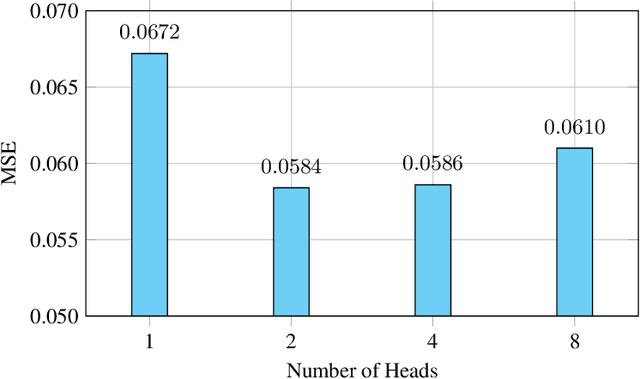

Abstract:This study addresses the critical challenge of predicting the Q-distribution in long-term stable nuclear fusion task, a key component for advancing clean energy solutions. We introduce an innovative deep learning framework that employs Modern Hopfield Networks to incorporate associative memory from historical shots. Utilizing a newly compiled dataset, we demonstrate the effectiveness of our approach in enhancing Q-distribution prediction. The proposed method represents a significant advancement by leveraging historical memory information for the first time in this context, showcasing improved prediction accuracy and contributing to the optimization of nuclear fusion research.
Multi-modal Fusion based Q-distribution Prediction for Controlled Nuclear Fusion
Oct 11, 2024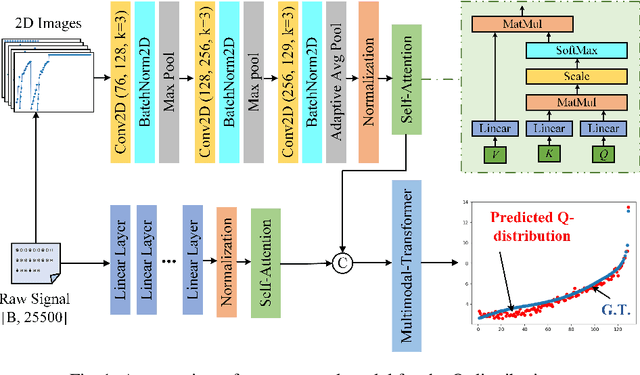


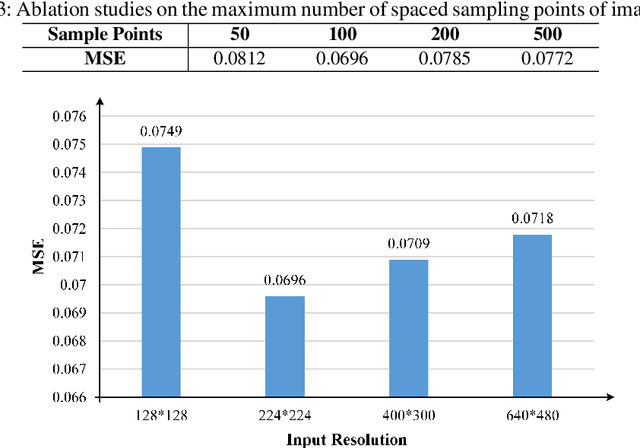
Abstract:Q-distribution prediction is a crucial research direction in controlled nuclear fusion, with deep learning emerging as a key approach to solving prediction challenges. In this paper, we leverage deep learning techniques to tackle the complexities of Q-distribution prediction. Specifically, we explore multimodal fusion methods in computer vision, integrating 2D line image data with the original 1D data to form a bimodal input. Additionally, we employ the Transformer's attention mechanism for feature extraction and the interactive fusion of bimodal information. Extensive experiments validate the effectiveness of our approach, significantly reducing prediction errors in Q-distribution.
CXPMRG-Bench: Pre-training and Benchmarking for X-ray Medical Report Generation on CheXpert Plus Dataset
Oct 01, 2024
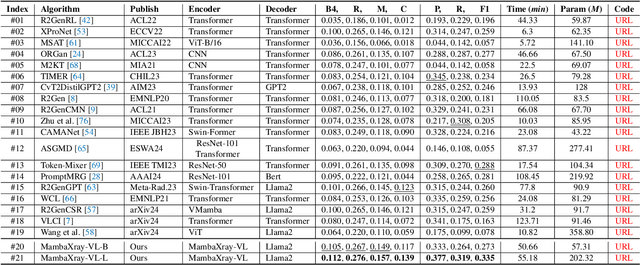
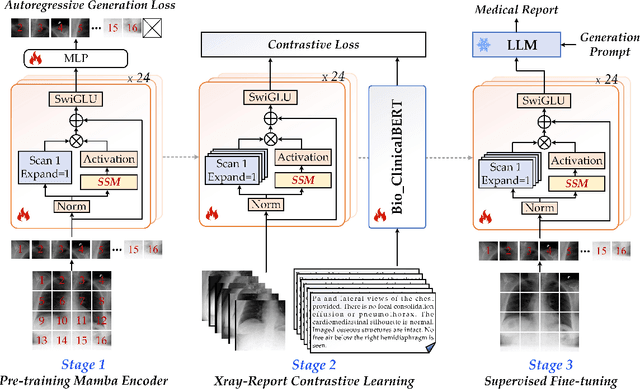
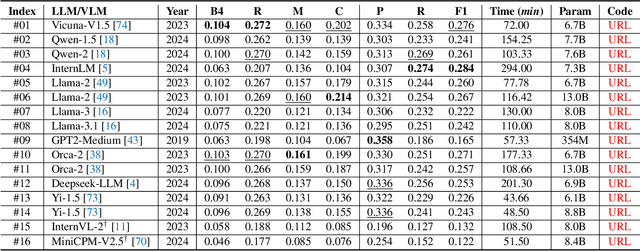
Abstract:X-ray image-based medical report generation (MRG) is a pivotal area in artificial intelligence which can significantly reduce diagnostic burdens and patient wait times. Despite significant progress, we believe that the task has reached a bottleneck due to the limited benchmark datasets and the existing large models' insufficient capability enhancements in this specialized domain. Specifically, the recently released CheXpert Plus dataset lacks comparative evaluation algorithms and their results, providing only the dataset itself. This situation makes the training, evaluation, and comparison of subsequent algorithms challenging. Thus, we conduct a comprehensive benchmarking of existing mainstream X-ray report generation models and large language models (LLMs), on the CheXpert Plus dataset. We believe that the proposed benchmark can provide a solid comparative basis for subsequent algorithms and serve as a guide for researchers to quickly grasp the state-of-the-art models in this field. More importantly, we propose a large model for the X-ray image report generation using a multi-stage pre-training strategy, including self-supervised autoregressive generation and Xray-report contrastive learning, and supervised fine-tuning. Extensive experimental results indicate that the autoregressive pre-training based on Mamba effectively encodes X-ray images, and the image-text contrastive pre-training further aligns the feature spaces, achieving better experimental results. Source code can be found on \url{https://github.com/Event-AHU/Medical_Image_Analysis}.
MambaEVT: Event Stream based Visual Object Tracking using State Space Model
Aug 20, 2024



Abstract:Event camera-based visual tracking has drawn more and more attention in recent years due to the unique imaging principle and advantages of low energy consumption, high dynamic range, and dense temporal resolution. Current event-based tracking algorithms are gradually hitting their performance bottlenecks, due to the utilization of vision Transformer and the static template for target object localization. In this paper, we propose a novel Mamba-based visual tracking framework that adopts the state space model with linear complexity as a backbone network. The search regions and target template are fed into the vision Mamba network for simultaneous feature extraction and interaction. The output tokens of search regions will be fed into the tracking head for target localization. More importantly, we consider introducing a dynamic template update strategy into the tracking framework using the Memory Mamba network. By considering the diversity of samples in the target template library and making appropriate adjustments to the template memory module, a more effective dynamic template can be integrated. The effective combination of dynamic and static templates allows our Mamba-based tracking algorithm to achieve a good balance between accuracy and computational cost on multiple large-scale datasets, including EventVOT, VisEvent, and FE240hz. The source code will be released on https://github.com/Event-AHU/MambaEVT
Event Stream based Human Action Recognition: A High-Definition Benchmark Dataset and Algorithms
Aug 19, 2024



Abstract:Human Action Recognition (HAR) stands as a pivotal research domain in both computer vision and artificial intelligence, with RGB cameras dominating as the preferred tool for investigation and innovation in this field. However, in real-world applications, RGB cameras encounter numerous challenges, including light conditions, fast motion, and privacy concerns. Consequently, bio-inspired event cameras have garnered increasing attention due to their advantages of low energy consumption, high dynamic range, etc. Nevertheless, most existing event-based HAR datasets are low resolution ($346 \times 260$). In this paper, we propose a large-scale, high-definition ($1280 \times 800$) human action recognition dataset based on the CeleX-V event camera, termed CeleX-HAR. It encompasses 150 commonly occurring action categories, comprising a total of 124,625 video sequences. Various factors such as multi-view, illumination, action speed, and occlusion are considered when recording these data. To build a more comprehensive benchmark dataset, we report over 20 mainstream HAR models for future works to compare. In addition, we also propose a novel Mamba vision backbone network for event stream based HAR, termed EVMamba, which equips the spatial plane multi-directional scanning and novel voxel temporal scanning mechanism. By encoding and mining the spatio-temporal information of event streams, our EVMamba has achieved favorable results across multiple datasets. Both the dataset and source code will be released on \url{https://github.com/Event-AHU/CeleX-HAR}
 Add to Chrome
Add to Chrome Add to Firefox
Add to Firefox Add to Edge
Add to Edge